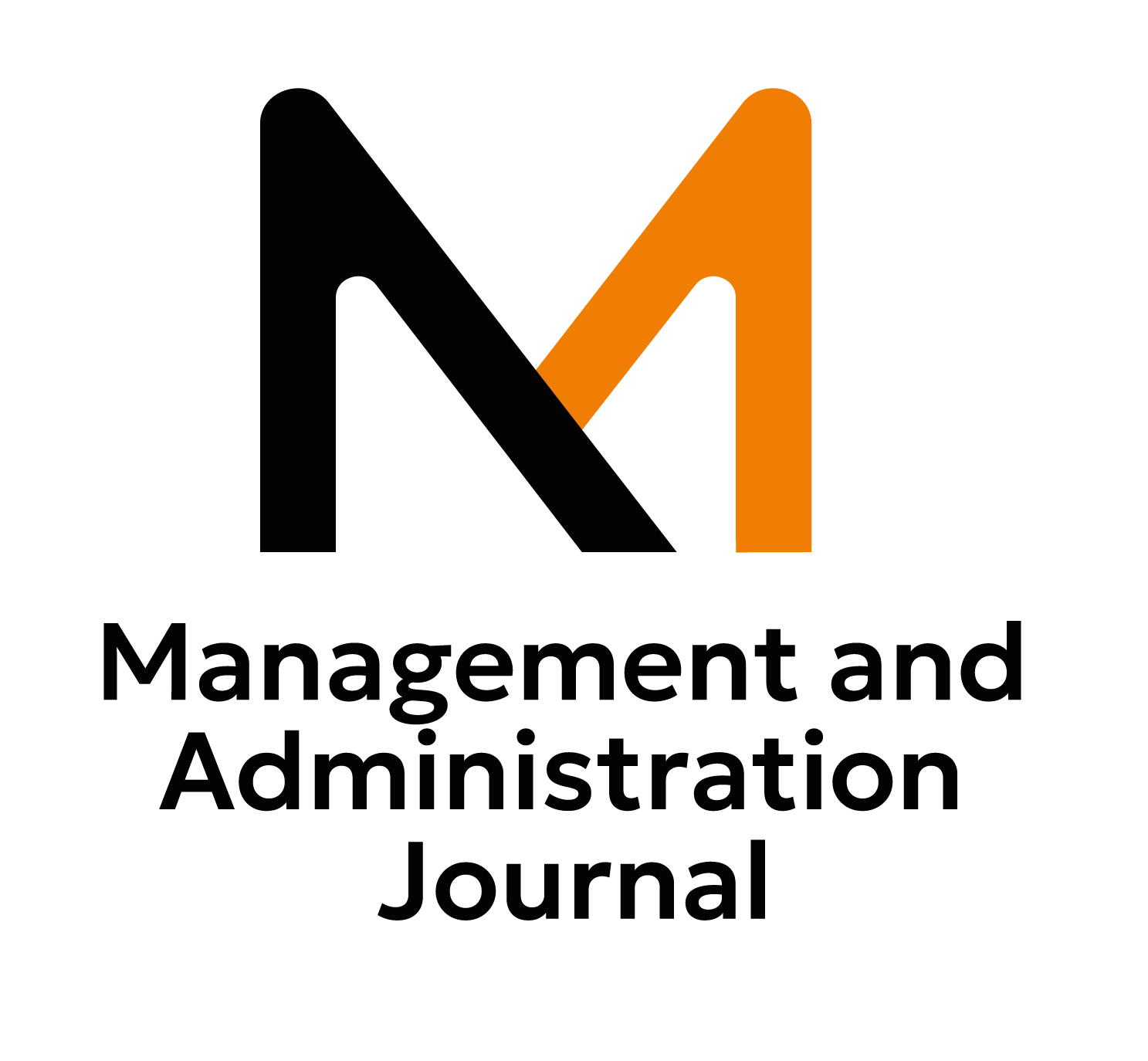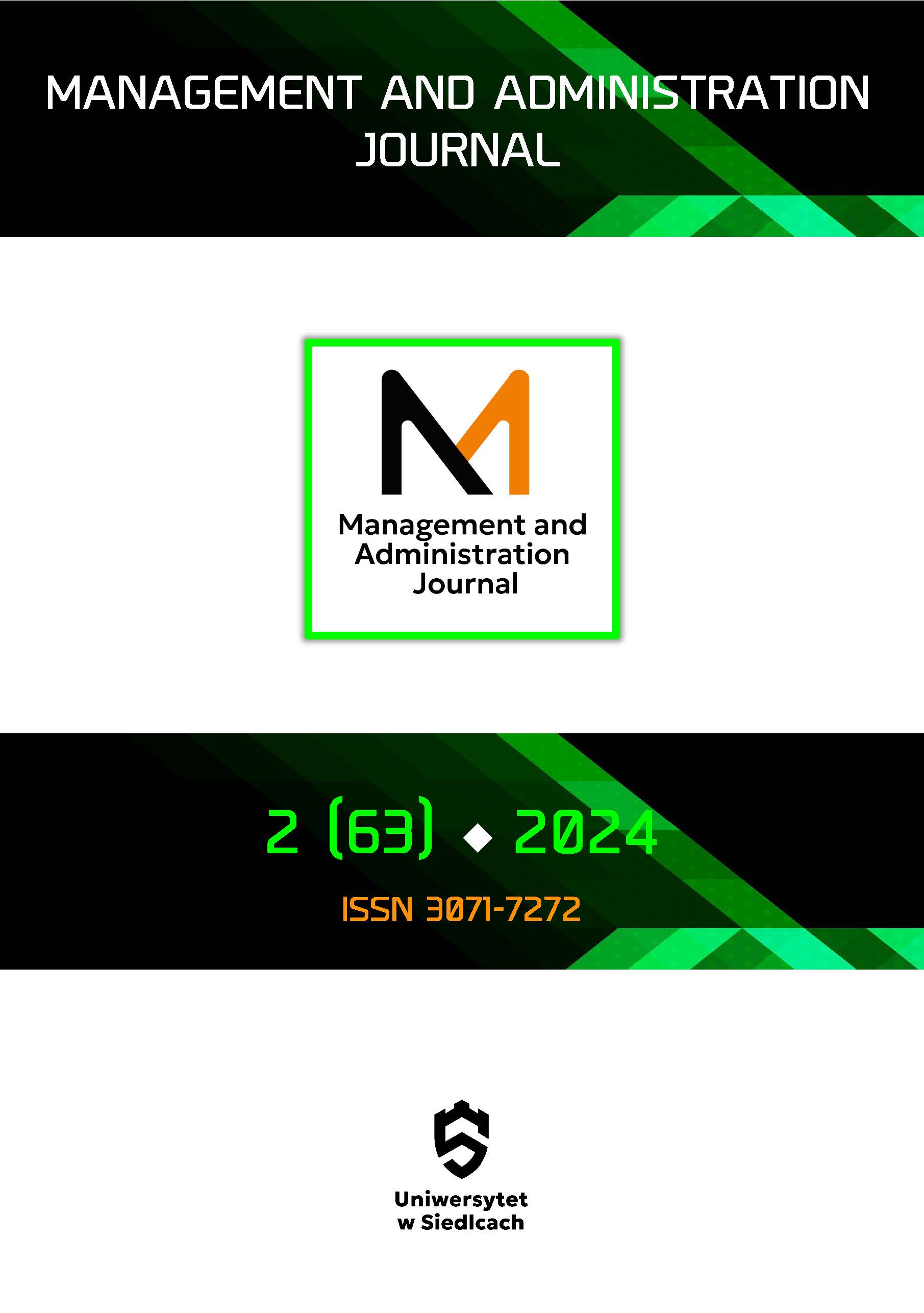MODELE I DZIAŁANIA BIZNESOWEW KIERUNKU GOSPODARKI CYRKULARNEJ
DOI:
https://doi.org/10.34739/maj.2024.02.04Słowa kluczowe:
zrównoważony rozwój, gospodarka cyrkularna, zamknięte pętle zasobówAbstrakt
Przejście na gospodarkę o obiegu zamkniętym oznacza fundamentalną zmianę w sposobie działania przedsiębiorstw, odchodzenie od tradycyjnego liniowego modelu „weź, wytwórz, pozbądź się” w kierunku systemu, który priorytetowo traktuje efektywność wykorzystania zasobów, redukcję odpadów i zrównoważone praktyki. Artykuł koncentruje się na badaniu modeli biznesowych i działań wspierających przejście na gospodarkę o obiegu zamkniętym. Celem jest identyfikacja modeli biznesowych zgodnych z zasadami gospodarki o obiegu zamkniętym; zbadanie, w jaki sposób przedsiębiorstwa wdrażają praktyki
gospodarki o obiegu zamkniętym w różnych obszarach oraz zidentyfikowanie kluczowych wyzwań i czynników, które wpływają na przejście przedsiębiorstw na praktyki gospodarki o obiegu zamkniętym. Rezultaty wskazują na dwa główne podejścia do obiegu zasobów: pierwsze to spowolnienie przepływów zasobów, a drugie to zamknięcie pętli zasobów. Ponadto zaprezentowano
praktyki wdrożeniowe na trzech poziomach: mikro, mezo i makro, w czterech obszarach: produkcji, konsumpcji, gospodarki odpadami i wsparcia rozwoju. W artykule przedstawiono obszar gospodarki cyrkularnej w kontekście zrównoważonego rozwoju, wskazując na jej potencjał w zakresie lepszego wykorzystania ograniczonych zasobów oraz redukcji emisji. Wnioski z artykułu podkreślają, że osiągnięcie globalnego modelu gospodarki o obiegu zamkniętym wydaje się nierealne.
Pobrania
Bibliografia
Accenture (2014). Circular Advantage. Innovative Business Models and Technologies to Create Value without Limits to Growth. Retrieved from https://www.accenture.com/pl-pl (access: 26.08.2024).
Arrow K. et al. (1995). Economic Growth, Carrying Capacity, and the Environment. Nature, 268.
Becque, R., Roy, N., Hamza-Goodacre, D. (2016). The political economy of the circular economy – lessons to date and questions for research. Retrieved from http://www.climateworks.org/wp-content/uploads/2016/12/CE-political-economy.pdf (access: 30.08.2024).
Bocken, N., de Pauw, I., Bakker, C., van der Grinten, B. (2016). Product design and business model strategies for a circular economy. Journal of Industrial and Production Engineering. Retrieved from https://www.researchgate.net/publication/309699661_Product_design_and_business_model_strategies_for_a_circular_economy (access: 30.08.2024).
Bukowski, H. (2018). W kierunku gospodarki cyrkularnej – rekomendacje rozwoju i implementacji praktycznych rozwiązań dla biznesu [Towards a Circular Economy – Recommendations for the Development and Implementation of Practical Business Solutions] Instytut Innowacyjna Gospodarka. Retrieved from http://ingos.pl/public/userfiles/pdf/ raport_w_kierunku_gospo-darki_cyrkularnej.pdf (access: 30.08.2024).
Chertow, M., Ehrenfeld, J. (2012). Self-Organizing Systems. Journal of Industrial Ecology, 16. https://doi.org/10.1111/j.1530-9290.2011.00450.x.
Ekins, P. et al. (2016). Resource Efficiency: Potential and Economic Implications Summary for Policymakers. DOI: 10.13140/RG.2.2.18978.43204.
EEA (2012). Environmental Indicator Report 2012. Ecosystem Resilience and Resource Efficiency in a Green Economy in Eu-rope. Retrieved from https://www.eea.europa.eu/publications/environmental-indicator-report-2012/environmental-indica-tor-report-2012-ecosystem
Ellen Macarthur Foundation (2013a). Towards the Circular Economy, Vol. 1: Economic and business rationale for a circular economy. Retrieved from https://www.ellenmacarthurfoundation.org/towards-the-circular-economy-vol-1-an-economic-and-business-rationale-for-an (access: 20.08.2024).
Ellen MacArthur Foundation (2013b). Towards the Circular Economy. Vol. 2: Opportunities for the Consumer Goods Sector. Retrieved from https://www.ellenmacarthurfoundation.org/towards-the-circular-economy-vol-2-opportunities-for-the-con-sumer-goods (access: 20.08.2024).
Ellen MacArthur Foundation (2014). Towards the Circular Economy Vol. 3: Accelerating the Scale-up Across Global Supply Chains. h Retrieved from ttps://www.ellenmacarthurfoundation.org/towards-the-circular-economy-vol-3-accelerating-the-scale-up-across-global (access: 20.08.2024).
Ellen MacArthur Foundation (2015a). Growth within: a circular economy vision for a competitive Eu-rope. Retrieved from https://www.ellenmacarthurfoundation.org/assets/downloads/publications/EllenMacArthurFoundation_Growth-Within_July15.pdf (access: 20.08.2024).
Ellen MacArthur Foundation (2015b). Towards a circular economy: business rationale for an accelerated transition. Retrieved from https://kidv.nl/media/rapportages/towards_a_circular_economy.pdf?1.2.1 (access: 20.08.2024).
European Parliament (2016). Closing the loop: new circular economy package. Retrieved from https://www.europarl.eu-ropa.eu/RegData/etudes/BRIE/2016/573899/EPRS_BRI%282016%29573899_EN.pdf (access: 30.08.2024).
European Commission (2020) COM(2020) 474. Critical Raw Materials Resilience: Charting a Path Towards Greater Security and Sustainability. Retrieved from https://eur-lex.europa.eu.
Gibbs, D. (2008). Industrial Symbiosis and Eco-Industrial Development: An Introduction. Geography Compass, 2(4),1138–1154. DOI: 10.1080/003434005200059959.
Geng, Y., Zhang, P., Côté, R.P., Qi, Y. (2008). Evaluating the applicability of the Chinese eco-industrial park standard in two industrial zones. International Journal of Sustainable Development and World Ecology, 15, 1-10. DOI:10.1080/ 13504500809469850.
Geng, Y., Zhu, Q.H., Doberstein, B., Fujita, T. (2009). Implementing China’s circular economy concept at the regional level: a review of progress in Dalian, China. Waste Management 29, 996-1002. DOI:10.1016/j.wasman.2008.06.036
Hens, L. et al. (2018). On the evolution of “Cleaner Production” as a concept and a practice. Journal of Cleaner Production, 172, 3323-3333. DOI: https://doi.org/10.1016/j.jclepro.2017.11.082;
Heshmati, A. (2015). A review of the circular economy and its implementation Entreprenörskapsforum. Report 1. Retrieved from https://entreprenorskapsforum.se/wpcontent/uploads/2015/12/CircularEconomy_webb.pdf (access: 30.08.2024).
International Resource Panel (IRP). (2020). Resource Efficiency and Climate Change: Material Efficiency Strategies for a Low-Carbon Future. United Nations Environment Programme. Retrieved from https://www.resourcepanel.org/reports/resource-efficiency-and-climate-change (access: 22.08.2024).
Ku, A.Y., Hung, S. (2014). Manage raw material supply risk. Critical Issues. Retrieved from https://www.aiche.org/sites/de-fault/files/cep/20140928.pdfhttps://www.aiche.org/sites/default/files/cep/20140928.pdf (access: 27.08.2024).
Lombardi, D.R., Laybourn, P. (2012). Redefining Industrial Symbiosis. Journal of Industrial Ecology, 16, 28-37. DOI: https://doi.org/10.1111/j.1530-9290.2011.00444.x
Lowe, E. (2001). Eco-industrial Park Handbook for Asian Developing Countries. Report to Asian Development Bank. Retrieved from https://www.researchgate.net/profile/Ernest-Lowe/publication/334204752_Eco-industrial_Park_Handbook_for _Asian_Developing_Countries_Report_to_Asian_Development_Bank/links/5d1cc4d6458515c11c0f0c23/Eco-industrial-Park-Handbook-for-Asian-Developing-Countries-Report-to-Asian-Development-Bank.pdf (access: 27.08.2024).
McDonough, W., Braungart, M. (2009). Cradle to Cradle: Remaking the Way We Make Things, Vintage.
Meadows, D.H. Meadows, D.L., Randers, J. (1973). Granice Wzrostu. [Limits of Growth], Warszawa: PWE.
Meadows, D.H., Meadows, D.L., Randers, J. (1995). Przekraczanie granic: globalne załamanie czy bezpieczna przyszłość [Crossing Borders: Global Collapse or a Secure Future]. Warszawa: Centrum Uniwersalizmu przy Uniwersytecie Warszawskim.
Moran, D. et al. (2015). Global supply chains of coltan. Journal of Industrial Ecology, 19, 357-365. DOI: https://doi.org/10.1111 /jiec.12206.
Murray, A., Skene, K., & Haynes K. (2017). The Circular Economy: An Interdisciplinary Exploration of the Concept and Applica-tion in a Global Context. Journal of Business Ethics140, 369-380. DOI: https://doi.org/10.1007/s10551-015-2693-2
OECD, (2011b). Towards Green Growth: Monitoring Progress – OECD Indicators, Retrieved from https://www.oecd-ili-brary.org/.
Stahel, W.R. (2008). The Performance Economy: Business Models for the Functional Service Economy, in: K.B. Misra (ed.), Handbook of Performability Engineering (10), 127-138. DOI: https://doi.org/10.1007/978-1-84800-131-2_10
Stahel, W.R. (2016). Circular economy, Nature (531). DOI: https://doi.org/10.1038/531435a.
United Nations Environment Programme (UNEP). (2019). Global Resources Outlook 2019: Natural Resources for the Future We Want. United Nations Environment Programme. Retrieved from https://www.resourcepanel.org/reports/global-re-sources-outlook-2019 (access: 22.08.2024).
UNEP (2011). Decoupling Natural Resource Use and Environmental Impacts from Economic Growth. Retrieved from https://wedocs.unep.org/20.500.11822/9816 (access: 27.08.2024).
UNIDO (2015). National Cleaner Production Centres 20 years of achievement https://www.unido.org/sites/default/files/ 2015-10/NCPC_20_years_0.pdf (access: 27.08.2024).
Ward J.D., Sutton P.C., Werner A.D., Costanza R., Mohr S.H., Simmons C.T. (2016). Is Decoupling GDP Growth from Environ-mental Impact Possible? PLoS ONE 11(10). DOI: https://doi.org/10.1371/journal.pone.0164733 (access: 28.08.2024).
Wu, H.Q., Shi, Y., Xia, Q., Zhu, W.D. (2014). Effectiveness of the policy of circular economy in China: A DEA-based analysis for the period of 11th five-year-plan. Resources, Conservation and Recycling (83), 163-175. DOI: https://doi.org/10.1016/j.rescon-rec.2013.10.003
Yang, S., Feng, N. (2008). A case study of industrial symbiosis: Nanning Sugar Co., Ltd. in China. Resources, Conservation and Recycling, (52), 813–820. DOI: https://doi.org/10.1016/j.resconrec.2007.11.008
Yuan, Z., Bi, J., Moriguichi, Y. (2006). The circular economy: a new development strategy in China. Journal of Industrial Ecology, 10, 4–8. DOI: https://doi.org/10.1162/108819806775545321
Zhou, K., Bonet Fernandez, D., Wan, C., Denis, A., Juillard, G.-M. (2014). A study on circular economy implementation in China. Working Papers (312), 13. IPAG Business School. Retrieved from https://faculty-research.ipag.edu/wp-content/uploads/re-cherche/WP/IPAG_WP_2014_312.pdf (access: 22.08.2024).
Zhijun, F., Nailing, Y. (2007). Putting a circular economy into practice in China. Sustainability Science, 2(1), 95-101. DOI: https://doi.org/10.1007/s11625-006-0018-1.
Pobrania
Opublikowane
Numer
Dział
Licencja
Prawa autorskie (c) 2024 Management and Administration Journal

Utwór dostępny jest na licencji Creative Commons Uznanie autorstwa – Użycie niekomercyjne 4.0 Międzynarodowe.





